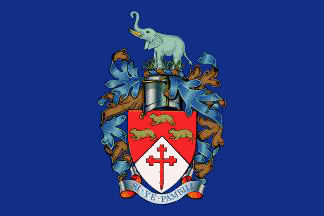
Last modified: 2022-10-22 by bruce berry
Keywords: bulawayo |
Links: FOTW homepage |
search |
disclaimer and copyright |
write us |
mirrors
 Image sent by Glenn Baker, 05 June 2013
See also:
Image sent by Glenn Baker, 05 June 2013
See also:
Bulawayo is Zimbabwe’s second largest city and stands on the site of the kraal of the Ndebele King Lobengula. Forces of the British South Africa Company (BSAC) invaded Matabeleland in 1893 causing Lobengula and his people to flee from their kraal after razing it to the ground. White settlers moved into the area and Bulawayo was declared a town on 1 June 1894 and became a municipality in 1897. City status was granted in 1943.
The municipal flag contains the municipal Arms in the centre of a blue
field.
On attaining municipal status in 1897 Bulawayo also adopted Arms which
were heraldically incorrect. The original design was a composite selection made from designs which had been submitted by members
of the public and consisted of a shield with an elephant in base on a green field with African huts (representing the
Cape Colony) on the left and Oriental-style buildings (representing Cairo) on the right. The main idea of this design
being to symbolise Cecil Rhodes’ dream of a Cape to Cairo railway. The field stretched to a horizon, in the middle of which was
a rising sun with three rays, above each of which from left to right were
the words "Justice", "Freedom" and "Commerce", from the BSAC arms.
After using this design for over 40 years, enquiries were made to the London College of Arms in 1939 with a view to having a new, heraldically correct, design being drawn up. In 1943 a design by V.W. Hiller, the first Rhodesian Government Archivist, was accepted by the Town Council and sent off for approval to the College of Arms. On the eve of the City’s 50th anniversary, the Town Clerk read out the Letters Patent of the Grant of Arms at a special meeting of the City Council on 4 November 1943.
The blazon of the arms is:
ARMS: Per chevron Gules and Argent in chief three rock rabbits courant
(Iimbela) in chief Or and in base a cross-crosslet fitche of the first.
CREST: On a wreath Or and Azure, an African elephant trunk elevated
statant among reeds proper.
MOTTO: "Si Ye Pambili "
The charges on the shield are mainly African in origin, the rock rabbits being the totem animal of the royal family of the Matabele tribe. The cross symbolises the influence of the early missionaries on the Matabele and the elephant crest comes from the seal used by Lobengula, last Paramount Chief of the Matabele. The motto, in Sindebele, means "Let us go Forward".
A flag for the City was also adopted following the granting of the municipal arms and comprises a royal blue field in the centre of which are the full Arms and motto of the City in colour. The flag in a pennant form is also used on the Mayoral car.
Unlike some of the other towns and cities in Zimbabwe, Bulawayo did not change its name following independence and its original “colonial” Arms and flag have also been retained.
Source: Municipal Flags in Zimbabwe,
lecture by Bruce Berry presented
at XVII ICV, Cape Town 1997) [brr99].
Bruce Berry, 21 Aug 2002
The animal (three of which are shown) in the upper part of the shield
of Bulawayo is the dassie or rock hyrax (Procavia capensis), often mistakenly
called rock rabbit. "Rock dassie" seems to be a conflation of the first
two names. "Dassie" is derived from Dutch ("das" + badger) and is
the only name the animals have in Afrikaans. It is also the usual English
name in South Africa. There are also many different names in the Bantu
languages. This animal lives on rocky surfaces, often cliff faces, and
is probably associated with Bulawayo because of the rocky hills, the Matobos
(colonial name Matopos) which overlook the city. This kind of animal is
mentioned in the Bible, since its area of distribution stretches from South
Africa (right across the country) to Israel. I'm not certain if the one
found in Israel is the exact same species, but dassies are certainly encountered
there. In the King James translation (Authorised Version) of the Bible,
they are called coneys.
Information on them can be found on this
webpage, among other sites.
Mike Oettle, 23 Aug 2002
byo.jpg) scan by
Bruce Berry, 11 Oct 2006
scan by
Bruce Berry, 11 Oct 2006
I have just come across your web site illustrating the coat of arms
of the City of Bulawayo and thought that you may be interested in the following.
I worked for the City Council in the early 70's and have seen what
I believe to be the original grant which was in those days displayed in
a glass case in the first floor concourse of the City Hall.
The blazon actually reads: "......three rock rabbits courant (Iimbela)
in chief one and two Or..........".
The "one and two" is carefully written in as an addition above the
main line.
If one looks carefully at the shield, it is possible to discern two
rock rabbits "painted out" in the upper corners.
The story I was told is that when the original grant arrived from London,
the blazon was as you have recorded it (I must admit that I cannot myself
recall the "Iimbela") with the three rock rabbits shown in one horizontal
line. Apparently that was not what the City Fathers wanted and the grant
was sent back to the College of Arms to be corrected. It was returned
with the two outer animals painted out and re-positioned below and the
words "one and two" squeezed in at the appropriate point.
Peter Bentham Hill, 27 Nov 2002